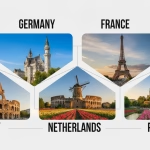Nordic trends: Stay up-to-date on the latest news and trends in Nordic finance. Discover reliable banking institutions and financial stability in the Nordics.

The Nordic countries are in the northern part of Europe and include Denmark, Norway, Sweden, Finland, Iceland, the Faroe Islands, Greenland, and Åland. Banking and financial systems in the Nordic countries are getting more interconnected. In this region, financial institutions and markets are closely linked and concentrated and often work together across borders. To some extent, these features can also be seen in other parts of Europe.
In this article, we will look into the Nordic financial system, discuss the regulatory bodies’ roles, and give you an overview of the banking sector.
Financial System in Nordic Countries
Financial intermediation has experienced notable growth and diversification in recent years, with an average recruitment of around 200,000 people in the Nordic countries. Over the past decade, most countries in the region have witnessed a nearly twofold increase in their total financial assets. This surge in demand for financial services can be attributed to the region’s economic expansion and comparatively low-interest rates.
Furthermore, a rising interest in equity markets and alternative investment opportunities has played a significant role in broadening the spectrum of financial assets within the region.
Denmark
Denmark’s financial system is known for its robustness and stability. The Danish Financial Supervisory Authority (DFSA), or Finanstilsynet, is the principal regulatory body overseeing the financial sector. It supervises banks, insurance companies, pension funds, and securities markets to ensure compliance with local and international regulations. DFSA focuses on maintaining financial stability, protecting consumers, and preventing financial crime.
Norway
Norway’s dual banking system, comprising commercial and savings banks, is overseen by the Financial Supervisory Authority of Norway (Finanstilsynet). This regulatory body supervises and regulates banks, insurance companies, pension funds, securities markets, and other financial institutions. Finanstilsynet’s mission is to safeguard financial stability, promote efficient markets, and protect the interests of consumers in Norway.
Sweden
Sweden’s universal banking model is under the watchful eye of the Swedish Financial Supervisory Authority (Finansinspektionen). This regulatory body oversees various financial institutions, including banks, insurance companies, and securities markets. Its primary objectives are to ensure financial stability, protect consumers, and maintain a well-functioning financial sector in Sweden.
Finland
Finland’s financial system is characterized by a concentrated banking sector and is regulated by the Financial Supervisory Authority (FIN-FSA), also known as Finanssivalvonta. This body supervises banks, insurance companies, pension funds, and securities markets. Its responsibilities include safeguarding financial stability, ensuring compliance with regulations, and protecting the interests of consumers in Finland.
Iceland
Iceland’s financial system has evolved to emphasize asset management and is monitored by the Financial Supervisory Authority of Iceland (FME), also known as Fjármálaeftirlitið. FME supervises banks, insurance companies, securities markets, and pension funds. Its primary goals are to maintain financial stability, ensure fair and transparent markets, and protect consumers’ financial interests in Iceland.
Territories: Faroe Islands, Greenland, and Åland
The autonomous territories within the Nordic region also have their financial systems and regulatory bodies:
Faroe Islands: The Faroe Islands’ financial sector is regulated by the Financial Supervisory Authority of the Faroe Islands (FSAF), ensuring compliance with local and international financial regulations.
Greenland: Greenland’s financial sector is overseen by the Greenland Home Rule Government’s Department of Finance, which manages financial matters within the territory.
Åland: Åland, an autonomous region of Finland, follows Finnish financial regulations, with oversight provided by the Financial Supervisory Authority (FIN-FSA) in collaboration with the Åland Islands Government.
The Banking System in Nordic Countries
Denmark
Denmark, often praised for its financial stability, follows a universal banking model. Danish banks offer a broad spectrum of financial services under one roof. Commercial banks in Denmark provide services ranging from savings accounts and loans to investment banking and asset management. This approach is convenient for customers, who can access various financial products through a single institution.
Norway
In Norway, the banking system operates on a dual banking model. This system combines commercial banks and savings banks. Commercial banks cater to a broad customer base and offer a comprehensive range of financial services like Denmark. On the other hand, savings banks often have a regional or community focus, contributing to financial inclusion and local development.
Sweden
Sweden shares the universal banking model with Denmark, where financial institutions provide various services. However, Sweden’s banking sector is more concentrated, with a few dominant banks playing a substantial role. While this can reduce competition, it also ensures stability and efficiency within the sector.
Finland
Finland’s banking sector is characterized by a highly concentrated presence of a few central banks. These banks serve the financial needs of individuals and businesses alike. The concentration of banking power allows for efficient financial services but necessitates careful regulatory oversight.
Iceland
Iceland’s banking system has evolved over the years, with a particular focus on asset management. Recently, there has been a growing interest in investment funds and pension funds. This emphasis on asset management provides Icelandic residents with various investment opportunities and secure financial planning options.
Autonomous Territories: Faroe Islands, Greenland, and Åland
The Nordic region includes three autonomous territories: The Faroe Islands, Greenland, and Åland. While these territories are subject to their unique governance arrangements, they also have distinct banking systems:
Faroe Islands: The Faroese banking system primarily consists of local banks that serve the specific needs of the Faroese population. These banks provide a range of financial services, ensuring that the community’s financial needs are met.
Greenland: Greenland’s banking sector is relatively small, focusing on serving local businesses and residents. Danish banks also operate in Greenland, offering a broader range of financial services.
Åland: Åland, an autonomous region of Finland, has a well-regulated and stable banking system. Åland’s financial institutions provide various services, including banking, insurance, and wealth management, to meet the financial requirements of the local population.
Shared Traits Across Nordic Banking Systems
While the Nordic countries and autonomous territories have their unique banking systems, they also share some common traits:
- Innovation and Digitalization: All these regions prioritize innovation and digitalization within the banking sector. Mobile banking, online payments, and digital investment platforms are widely available, making it convenient for residents to manage their finances.
- Robust Regulatory Frameworks: Nordic countries are known for their stringent regulatory frameworks to ensure financial stability and consumer protection. Regulatory bodies closely monitor financial institutions to maintain public trust.
- Economic Stability and Low Risk: These regions benefit from overall economic stability and low risk, contributing to the resilience of their banking systems even during global economic downturns.
- Sustainability and Ethical Finance: Many banks in the Nordic region integrate environmental, social, and governance (ESG) criteria into their investment decisions, aligning financial growth with social responsibility.
Types of Bank Accounts in Nordic Countries
Following are the standard bank account types in the Nordic countries. Keep reading to know the proper account for your financial goals.
Everyday Transaction Accounts
Everyday transaction accounts are the most basic and essential bank accounts in Nordic countries. These accounts are a hub for daily financial activities, such as receiving your salary, making payments, and managing expenses. Key features include:
- Debit Card: Linked to your transaction account, a debit card allows you to make purchases and withdraw cash from ATMs.
- Online and Mobile Banking: Access your account 24/7 through online and mobile banking apps, making it easy to check balances, pay bills, and transfer funds.
- No or Low Fees: Many banks offer fee-free or low-fee transaction accounts, making them a cost-effective choice.
Savings Accounts
Savings accounts are designed to help you grow your money over time while keeping it accessible for emergencies or planned expenses. Features of savings accounts in Nordic countries include:
- Interest Earnings: Savings accounts typically earn interest on your deposited funds, encouraging you to save.
- Easy Access: While not as readily accessible as transaction accounts, savings accounts allow you to withdraw funds when needed.
- Variety of Options: Banks offer different types of savings accounts, such as regular savings accounts, youth savings accounts, and specialized accounts for specific savings goals.
Fixed-Term Deposit Accounts
Fixed-term deposit accounts, also known as time deposits or certificate of deposit accounts, are designed for those who want to earn higher interest rates on their savings by locking in their funds for a specific period. Key features include:
- Higher Interest Rates: Fixed-term deposits generally offer higher interest rates than regular savings accounts.
- Term Length Options: You can choose the duration of your deposit, ranging from a few months to several years.
- Penalties for Early Withdrawal: Typically, you can only access your funds after the agreed-upon term if you incur penalties.
Youth and Student Accounts
Nordic countries strongly emphasize financial education and encourage young people to start saving and managing their finances early. Youth and student accounts cater specifically to this demographic with features such as:
- Low or No Fees: Many youth and student accounts have minimal fees to accommodate students’ limited budgets.
- Financial Education: Some banks provide financial education resources and tools to help young account holders learn about budgeting and saving.
- Customized Features: These accounts often include features like overdraft protection and mobile banking apps to suit the needs of younger customers.
Investment Accounts
For individuals looking to invest in stocks, bonds, and other financial instruments, Nordic countries offer investment accounts that provide access to financial markets. Critical aspects of investment accounts include:
- Diverse Investment Options: You can invest in various asset classes, including equities, mutual funds, and bonds.
- Professional Guidance: Many banks offer investment advisory services to help customers make informed investment decisions.
- Risk Tolerance Assessment: Banks may assess risk tolerance to recommend suitable investment strategies.
Foreign Currency Accounts
Nordic countries have a significant international presence; many residents conduct business or hold assets in foreign currencies. Foreign currency accounts cater to this need by offering:
- Multi-Currency Options: These accounts allow you to hold and transact in multiple foreign currencies.
- Currency Exchange Services: Banks often provide competitive exchange rates and services for converting between currencies.
- International Wire Transfers: Easy access to international wire transfer services for business or personal use.
Specialized Accounts
Nordic countries also offer specialized accounts to meet specific financial needs. Examples include:
- Business Accounts: These accounts come with features like merchant services and business loans and are tailored for business owners.
- Pension Accounts: Designed for retirement savings, these accounts offer tax benefits and long-term wealth accumulation.
- Charity and Nonprofit Accounts: Financial institutions may provide specialized accounts for charitable organizations, simplifying their financial management.












